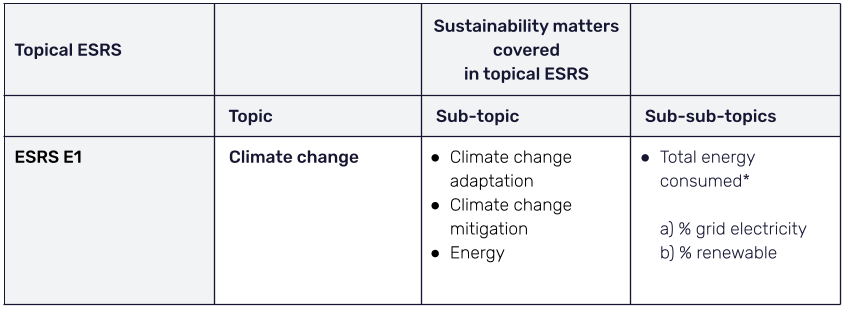
Getting your ESG data ready for the Corporate Sustainability Reporting Directive
7 May 2024
A brief introduction: What is the Corporate Sustainability Reporting Directive?
The Corporate Sustainability Reporting Directive (CSRD or the Directive) requires companies to report on sustainability and their sustainability impact including actions on society and the environment. It is an EU initiative aimed at improving the transparency and comparability of environmental, social and governance (ESG) information provided by companies.
This article will also touch upon European Sustainability Reporting Standards (ESRS). These are the standards that companies will report to and encompass 16 separate standards for areas of environmental, social and corporate governance.
The first CSRD reports will be published in 2025, for the companies who will report on 2024 data. The number of companies falling under the reporting obligation will increase year-on-year thereafter.
Data and the CSRD
Gathering the right data is going to present one of the biggest challenges for companies that need to report on their sustainability. Even those companies expecting to use ESG consultants to assist in complying with the CSRD will still need to gather and prepare data in-house.
In this article, I’m going to:
- Explain further the data challenge of the CSRD
- Give you a framework and some tips to help you get your ESG data CSRD-ready
- Consider the strategic and operational benefits of the CSRD
CSRD reporting cuts across an entire organisation. For this article I’ll discuss data primarily in the context of IT departments. Nevertheless, a diverse range of stakeholders in every company will need to prepare for the CSRD, beyond just IT departments.
The challenge of data gathering
One reason IT departments may struggle with reporting obligations under the CSRD is that obtaining the right data metrics is difficult.
So, to consider this part of the organisation as an example, let's take a look at one standard – ESRS E1 – which lists the requirements on Climate Change reporting, and discuss at an abstract level how it relates to an IT Department. This may cover many areas such as:
- Data centres
- Cloud
- Devices
- Applications
- Infrastructure
Every IT department will be slightly different from an infrastructure and device management perspective, nonetheless, organisations will need to investigate, understand and document each one of these areas and then extract the relevant data metrics.
The good news? Figuring out how to optimise this data gathering process will benefit the entire organisation.
How to optimise the process of data gathering – and benefit from it?
So, how can an organisation use the outcomes of data gathering, not only to meet regulatory obligations, but also to bring about tangible benefits, efficiencies and good governance?
To answer this question, let’s continue with the example of the Climate Change standard of the CSRD, ESRS E1.
Example: ESRS E1- Climate Change
The Climate Change standard offers a good example of the benefits to taking a systematic and forward-looking view to CSRD reporting compliance.
When looking at a specific standard, it will be useful to visualise the topics and dependencies within each topic. Many ratings and certifications agencies will have already created examples. Here is one suggested best practice example from the Global Reporting Initiative (GRI) which has also been leveraged by the European Commission and European Financial Reporting Advisory Group (EFRAG) when designing ESRS standards:

*Note: Of course, total energy consumed and understanding energy sources can be tricky. It may, for example, apply not only to an organisation’s offices, but also its data centres or cloud environments.
To begin the daunting task of generating the required data metrics and being able to start to use that data to work on these other subtopics (such as climate change adaptation and mitigation in the above table) it can be helpful to use a framework.
I’ll now share a version of a framework you can use to aid your approach to complying with the CSRD – and turn the challenge of data gathering into an opportunity for improvement.
5-step framework for getting your data CSRD-ready
The first two steps are fundamental prerequisites to cover before you can optimise and benefit from the CSRD data gathering process whilst the final three are more practical steps for getting your ESG data CSRD-ready.
[Fundamental prerequisites]
Step 1. Understand what data is relevant to your business and what you need to report on.
This means understanding the relationship to ESRS Topics and your business’:
- Strategy
- Business model
- Value chain
Understanding these relationships helps extract the right data metrics and utilise them for future climate adaptation and mitigation actions and improvements.
Step 2. Understand the CSRD standards (ESRS) that are relevant to your industry and organisation
To comply with the Directive, you will need to understand the relevant standards. This means performing a Double Materiality assessment or simply put, determining which of the ESRS topics are ‘material’ to your business. Without going into the intricacies, the end result should determine if the topic has a significant impact (i.e. positive or negative impact on activities or financial performance) and if it is important to key stakeholders, employees and suppliers.
This means conducting a materiality assessment for each ESRS Topic to uncover what is material when viewed from the lens of your business’s strategy, model and value chain.
The Directive and standards are quite clear on the need to assess also those risks and opportunities available.
[Optimise and benefit from the CSRD]
Step 3. Understand and prioritise material ESRS Topics in your business and strategy
Once material topics have been identified and viewed through the lens of your business’ strategy, business model, and value chain, it is a good time for the company to make use of this information.
ESRS E1 - Climate Change, is a topic that will inevitably be relevant / material. Therefore, understanding scope 1 (Direct), 2 and 3 (Indirect) emissions may be necessary as this will enable understanding of the Company’s past, current and future emissions and help to optimise current and future IT operations. Some examples include:
Scope 1 - Company-owned IT devices
Scope 2 - Purchased electricity usage
Scope 3 - Downstream suppliers such as public cloud usage
If you’re interested in better understanding IT-related emissions, check out this infographic: Your IT operations have an environmental impact.
Step 4. Gather the data to improve your business’s operations and carbon footprint
Once you have prioritised Climate Change as a topic and understand your company’s IT emissions we can then move to data gathering. How you go about this will depend on the solution to your data gathering challenge. There may be various solutions available but we will take public cloud as an example. For public cloud carbon dashboards are a good first step and available for free on each hyperscaler’s environment.
Like other ways to gather data in other industries, these have benefits and limitations, but I won’t cover these in this article. You can learn more about hyperscaler sustainability solutions in this article.
Whilst there may be a need to rely on hyperscaler data and promises, this is not where the journey stops. Now we have sufficient data for reporting but also to start creating a strategy to optimise our company’s IT operations and create significant operational efficiencies.
Step 5. Create and implement a strategy to improve your business footprint
Ultimately, the goal should be to use the Directive to identify material topics and understand the impacts, risks and opportunities of your current operations.
This should enable planning and implementation of effective strategies to reduce the environmental impact of your operations but also to drive efficiencies.
For climate change mitigation and adaptation in cloud, this might mean looking at what elements can be tailored in cloud environments to reduce emissions through FinOps and GreenOps:

In practice, a sustainable approach to data might look like:
- Ensuring that downtime generates no cost (aside from storage), and that there’s no irrelevant data duplication
- Best practices are followed when designing and modelling data, so querying is efficient and fast
- Energy consumption is fully optimised and that cloud native services used come from regions (or data centres) powered by renewables
- You can read more in this blog about how to use data design (intermittent data pipelines) to improve your sustainability on cloud
Leveraging the strategic benefits of the CSRD
Compliance under the CSRD might seem like a daunting undertaking, but there are significant opportunities to benefit from the process of gathering and understanding the related data.
Taking a systematic approach to CSRD compliance – whether with a framework or not – helps you to tap into those benefits, whether it’s:
- Improving your data-driven decision-making
- Leveraging greater cost efficiencies (from cutting waste)
- Enjoying reputational benefits (from improving impacts on society and the environment)
An IT department might, for example, use GreenOps/ FinOps to optimise the organisation's cloud setup as part of compliance with the ESR Climate Change and as an opportunity to mitigate and adapt its activities and reap the associated benefits.
In this case, compliance with the Directive has multiple positive effects. It can help you to reduce the carbon emissions associated with your cloud resources, whilst at the same time also:
- Save costs
- Cut waste
- Improve IT efficiencies
Ultimately, every company can benefit from taking a proactive approach to complying with the CSRD – by discovering your own opportunities for improvement and growth that arise from the process of getting your data CSRD-ready.
Get in Touch.
Let’s discuss how we can help with your cloud journey. Our experts are standing by to talk about your migration, modernisation, development and skills challenges.






